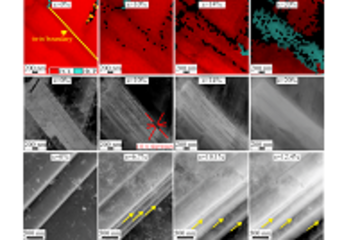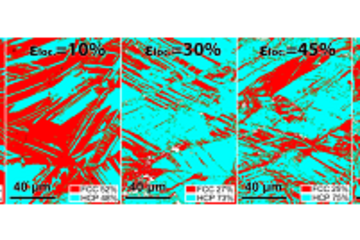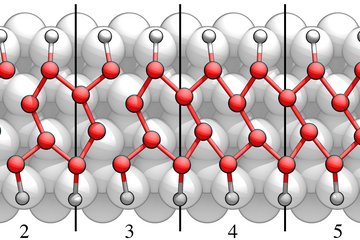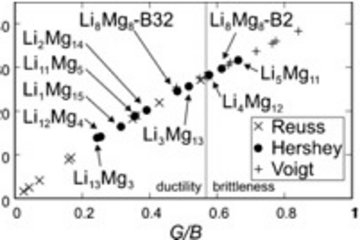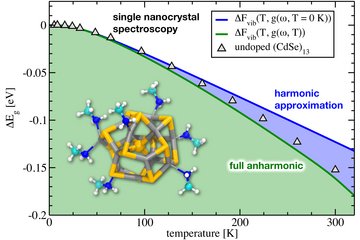All genres
21.
Talk
Application of combined spectroscopic, electrochemical and microscopic techniques for the understanding of adhesion and de-adhesion at polymer/metal interfaces. 24. Spektrometertagung, Dortmund, Germany (2005)
22.
Talk
Anwendung einer neuen höhenregulierbaren Rasterkelvinsonde zur Untersuchung der Stabilität von Klebstoff-Metall-Grenzflächen in feuchten und korrosiven Atmosphären. Swissbonding, Rapperswil am Zürichsee, Switzerland (2005)
23.
Talk
Metal/Polymer Grenzflächen. NACE, Housten, USA (2005)
24.
Talk
Fundamentals and Applications of a new height regulated Scanning Kelvin Probe in Corrosion and Adhesion Science. ISE 2004, Thessaloniki, Greece (2004)
25.
Talk
Introduction of a height regulated Scanning Kelvin Probe for the simultaneous measurement of surface topography and interfacial electrode potentials in corrosive environments. ISE Conference, 55th Annual Meeting, Thessaloniki, Greece (2004)
26.
Talk
Tailored adhesion promoting and corrosion resistant thin plasma polymer films at adhesion/metal interface. Ninth International Conference on Plasma Surface Engineering, Garmisch-Partenkirchen, Germany (2004)
27.
Talk
Water diffusion measurements in a model adhesive/silicon lap joint using FTIR-spectroscopy: Differentiation between bulk and interfacial diffusion. Euradh 2004, Freiburg, Germany (2004)
28.
Talk
Extended Abstract: Water diffusion measurements in a model adhesive/silicon lap joint using FTIR-spectroscopy: differentiation between bulk and interfacial diffusion. Euradh2004/Adhesion2004, Freiburg, Germany (2004)
29.
Talk
Extended Abstract: Non-destructive, in-situ measurement of de-adhesion processes at buried adhesive/metal interfaces by means of a new scanning Kelvin probe blister Test. Euradh2004/Adhesion2004, Freiburg, Germany (2004)
30.
Talk
Applications of a new height regulated Scanning Kelvin Probe for the study of polymer/metal interfaces in corrosive environments. ICEPAM 2004, Helsinki, Finnland (2004)
31.
Talk
Non-destructive, real time in-situ measurement of de-adhesion processes at buried adhesive/metal interfaces by means of a new Scanning Kelvin Probe Blister Test. Annual Meeting of the American Adhesion Society, Wilmington, UK (2004)
32.
Talk
Application of the Scanning Kelvin Probe for the study of de-adhesion processes at thin film engineered adhesive/metal interfaces. Annual Meeting of the American Adhesion Society, Wilmington, UK (2004)
33.
Talk
Scanning Kelvin Probe measurements of electrode potentials at adhesive/metal interfaces in corrosive environments. Bunsentagung, Kiel, Germany (2003)
34.
Poster
Hydrated Ion Transport at Polymer/Oxide/Metal-Interfaces in Non-Corrosive Atmosphere: Influence of Electric Field Gradients. Gordon Conference Graduate Research Seminar on Aqueous Corrosion, Colby Sawyer College, New London, NH, USA (2008)
35.
Poster
Applications of a Scanning Kelvin Probe for Studying Modified Adhesive/Metal Interfaces under Corrosive and Mechanical Load. 3rd World Congress on Adhesion and Related Phenomena, WCARP-III, Beijing, China (2006)
36.
Poster
Non-destructive, In-Situ Measurement of De-Adhesion Processes at Buried Adhesive/Metal Interfaces by Means of a New Scanning Kelvin Probe Blister Test. EUROMAT 2005, Prague, Czech Republic (2005)
37.
Poster
The application of the scanning Kelvin probe for investigating the deadhesion of adhesives on iron and zinc. EURADH 2002, Glasgow, UK (2002)
38.
Thesis - PhD
Grenzflächenchemische und elektrochemische Untersuchungen zur Haftung und Enthaftung an modifizierten Klebstoff/Metall-Grenzflächen. Dissertation, Ruhr-Universität Bochum, Fakultät für Chemie, Bochum, Germany (2006)




